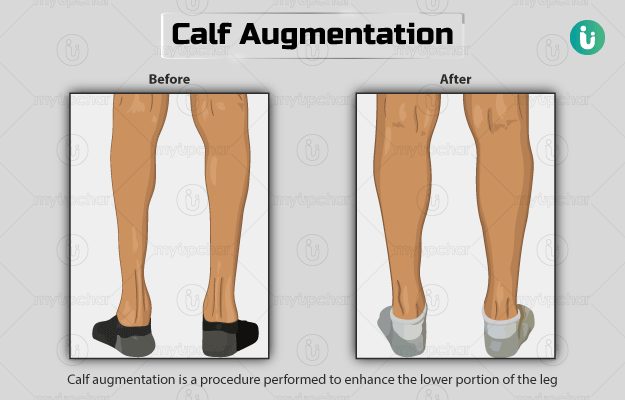Summary
Calf augmentation is a cosmetic surgery to improve the appearance of the calf by inserting a silicone implant. It may be performed in individuals with a narrow calf, bodybuilders who want to enhance their upper calf volume or people who have a lower limb amyotrophy. However, the surgery is contraindicated if circulation in your legs is compromised or if you have unrealistic expectations from the procedure. The doctor will need your medical history and ask you to undergo some tests. He/she will take some photos of your legs fro comparison after the procedure.
The doctor will make the presurgical markings and perform the procedure under general, local, or epidural anaesthesia. The surgery takes about ninety minutes. After the procedure, you will need bed rest for about 12 hours after and would need to stay in the hospital for two nights. You may initially need crutches to walk. In a few days, however, you will be able to get back to your normal activities.
Some of the risks of this surgery include infections, bleeding, rupturing of the implant, compartment syndrome, and seroma; however, the surgery can improve the aesthetic appeal of your lower leg.
- What is calf augmentation?
- Why is calf augmentation recommended?
- Who can and cannot get calf augmentation?
- What preparations are needed before calf augmentation?
- How is calf augmentation done?
- How to care for yourself after calf augmentation?
- What are the possible complications/risks of calf augmentation?
- When to follow up with your doctor after a calf augmentation?
What is calf augmentation?
Calf augmentation is a surgical procedure to make the calves fuller by placing silicone implants under calf muscles.
The surgery can be done to increase the aesthetic appeal in such individuals or to even out the difference in appearance between a person's legs caused by trauma, infection, or birth defect.
Calf implants need to be accurately chosen depending on factors such as a person’s requirements, assessment of the leg by the doctor, and the extent of damage and deformity in the leg. Mostly, silicone implants are used for the surgery, and currently, they are available in two shapes: an asymmetrical shape with a wider top or a symmetrical, cigar-shaped implant. The implants are made of a solid silicone elastomer or consist of a silicone shell filled with silicone gel.
Why is calf augmentation recommended?
Calf augmentation may be performed for aesthetic correction of lower limb amyotrophy (a group of deformities in the leg such as asymmetric, thin, or bent calf as compared to the other leg). This may be caused due to polio, clubfoot, or as a consequence of trauma, surgery, cerebral palsy, burns, or radiation therapy for tumours. Although the procedure corrects the deformities, it does not improve the functioning of the affected leg and is just cosmetic.
It may also be performed in people who have thin lower legs and bodybuilders who wish to bulk up on the calves.
Who can and cannot get calf augmentation?
The surgery is not be performed in individuals with the following conditions:
- Unrealistic expectations
- If the circulation in the tissues of the legs is hampered
- Serious health problem
What preparations are needed before calf augmentation?
The following preparations are needed for this surgery:
- Your doctor will ask you to share your complete medical history order a few tests, including:
- Urine tests
- Blood tests
- Pregnancy test
- Photos of your calf from different angles will be taken to make a comparison before and after the surgery.
- Bodybuilders who take anabolic steroids (synthetic variations of the male sex hormone testosterone) should inform the doctor as these drugs can increase the risks of complications after the surgery.
- Arrange for a responsible adult like a friend or relative to take you home after the surgery.
- Tell your doctor if you take any medicines including over-the-counter medications or herbs.
- Discontinue aspirin, warfarin, ibuprofen, or other blood-thinning medicines prior to the procedure.
- Your doctor will ask you to stop smoking a few weeks before the surgery. Read more: Harmful effects of smoking on body
- You will need to fast from midnight before the procedure.
- You will be asked to sign an approval form if you agree to the procedure.
How is calf augmentation done?
Once you arrive at the hospital, the hospital staff will ask you to undress and wear a hospital gown. Presurgical markings will be made at the site of incision (cut) or insertion site on your leg while you are standing. An intravenous line will be attached to your hand to provide you with essential medicines and fluids during the surgery.
The surgery may be performed with general anaesthesia (medicine given to make you fall asleep), local anaesthesia (numbs the area of operation) with sedatives (medications that make you feel drowsy) administered intravenously, or epidural anaesthesia (numbs the lower half of the body).
The leg that is to be operated on will be drained of blood with the help of a special bandage to lower the risk of swelling and bruising. You will be made to lie down on your chest on the operating table. The surgeon will perform the operation in the following manner:
- The surgeon will make a 4 to 5 cm long cut on the fold behind your knee.
- Based on the proposed location of the implant, he/she will cut under your skin or between the fascia (tissue that surrounds a muscle) and the underlying muscle to form a cavity to place the implant.
- Then, the surgeon will place in the implant properly into the cavity in a way that it does not move.
- If two implants are to be placed, the surgeon will take care not to disturb the nerves and veins in the region.
- The surgeon will then close all the layers of tissues sequentially with sutures (stitches), and cover the incision on your skin with Steri-Strips.
The surgery lasts for about an hour and a half. For 24 hours after the surgery, pain medicines will be administered to you intravenously. You will be advised complete bed rest with your legs elevated for about 12 hours and will have to stay in the hospital for around two nights.
During your hospital stay, you will be allowed to visit the washroom. The pain you feel, and the pulse in the arteries in your legs will be regularly checked. Make sure to stretch your legs regularly after the surgery to keep up your circulation. The medical team will apply a tape on your lower leg to prevent the movement of the implant and provide compression on your calf for one week after the surgery.
How to care for yourself after calf augmentation?
Once at home, you will need to take care of yourself in the following manner:
- Take proper rest for about a week.
- For about two weeks, you may need to walk with the help of crutches. Gradually, you will be able to bear weight on your leg.
- Keep your leg elevated as much as possible while sitting for the initial five to six weeks.
- You will not need any physical therapy following the procedure.
- You can resume your regular activities five to 10 days after the surgery. You will be able to play sports in about a month. Weightlifters can continue with their weight lifting activities after six weeks.
- Avoid exercising for a few weeks after the surgery.
- Keep the incision covered with tape, and do not expose the cut to sunlight for six months.
- You may be allowed to consume alcohol after about three weeks.
- Compression bandages should be worn for at least two weeks after the surgery. This will help prevent blood clots.
When to see the doctor?
Visit or call your doctor if you experience the following symptoms:
- Pain in the leg
- The veins around the surface of the leg get enlarged
- The skin on your leg is looking discoloured or hot
- Swelling in your leg
- Fever
- Opening of the incision
- Pus formation
- Numbness
- Increased fatigue
What are the possible complications/risks of calf augmentation?
Some risks associated with calf augmentation include:
- Scar hypertrophy (scars that are raised and do not blend into the surrounding tissue)
- Herniation of the implant (protruding of the implant requiring surgery to correct the position of the implant)
- Infection
- Compartment syndrome (a painful condition due to excessive pressure in muscles)
- Seroma (pooling of fluid at the incision site)
- Cosmetic dissatisfaction
- Rupturing of the implant
- Bleeding
- Capsular contracture (scar tissue formed around the implant)
When to follow up with your doctor after a calf augmentation?
Your doctor will schedule a follow-up visit three weeks after the surgery to remove your sutures.
Disclaimer: The above information is provided purely from an educational point of view and is in no way a substitute for medical advice by a qualified doctor.
Find Plastic, cosmetic and reconstructive surgeon in cities
- Plastic, cosmetic and reconstructive surgeon in Gwalior
- Plastic, cosmetic and reconstructive surgeon in Chennai
- Plastic, cosmetic and reconstructive surgeon in Gorakhpur
- Plastic, cosmetic and reconstructive surgeon in Raipur
- Plastic, cosmetic and reconstructive surgeon in Mumbai
- Plastic, cosmetic and reconstructive surgeon in Jaipur
Surgery Cost In Your City
Doctors for Calf augmentation

Dr. Raajshri Gupta
Plastic, Cosmetic & Reconstructive Surgery
8 Years of Experience

Dr. debraj shome
Plastic, Cosmetic & Reconstructive Surgery
9 Years of Experience

Dr. Chandan Sahu
Plastic, Cosmetic & Reconstructive Surgery
10 Years of Experience

Dr. Navdeep
Plastic, Cosmetic & Reconstructive Surgery
11 Years of Experience
References
- utmb Health [Internet]. University of Galveston. Texas. US; Plastic surgical procedures: Body Contouring
- Mundinger GS, Vogel JE. Calf augmentation and reshaping with autologous fat grafting. Aesthet Surg J. 2016 Feb;36(2):211–220. PMID: 26333990.
- Cavalcanti TOL, Pitanguy I, Ribeiro LMB, Oliviera FFG. Inclusion of calf implants for the correction of lower limb amyotrophy. Rev. Bras. Cir. Plást. 2011 Sep;26(3):518–524
- Niechajev I, Krag C. Calf augmentation and restoration: long-term results and the review of the reported complications. Aesthetic Plast Surg. 2017 Oct;41(5):1115–1131. PMID: 28488211.
- National Health Service [Internet]. UK; Having an operation (surgery)
- Hernandez A, Sherwood ER. Anesthesiology principles, pain management, and conscious sedation. In: Townsend CM Jr, Beauchamp RD, Evers BM, Mattox KL, eds. Sabiston Textbook of Surgery. 20th ed. Philadelphia, PA: Elsevier; 2017:chap 14
- International Society of Aesthetic Plastic Surgery [Internet]. New Hampshire. US; Calf Implants
- Orthoinfo [internet]. American Academy of Orthopaedic Surgeons. Rosemont. IL. US; Compartment Syndrome.















